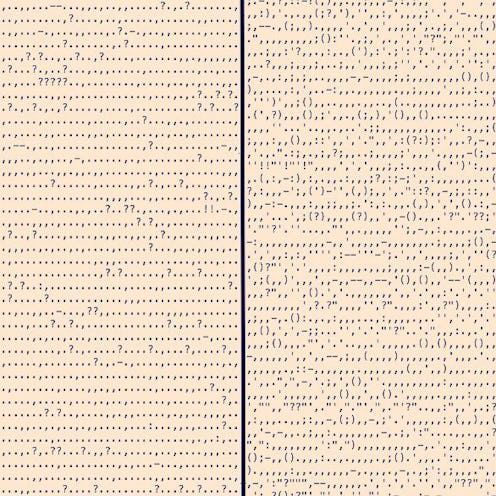Books
What Happens When You Read A Book With No Words?

When reading a classic book, we tend to pay attention to the themes, the characters, and the story. We say the words aloud. We notice everything, in fact, except for one crucial thing: the punctuation. That’s what scientist and writer Adam J. Calhoun noticed — and so he decided to investigate just how important those pesky dots and dashes can be. And it turns out, when you look at only the punctuation in books, you’ll see that punctuation use has changed a lot over the years.
Calhoun’s interest was sparked by an art project that went viral back in January, in which web developer Nicholas Rougeux took only the punctuation from classic literature and made posters from them. Calhoun took this one step further, and actually started analysing the differences in punctuation between the various works of literature.
After all, as Calhoun pointed out on his Medium post, punctuation actually says a lot more than we give it credit for. “Look at the array of dots and dashes,” he says. “Both meaningless and yet so meaningful. We can look and say: brief sentence; description; shorter description; action; action; action.”
Placing the punctuation from Blood Meridian to the left of that of a denser novel like Absalom, Absalom! shows clearly how much of a contribution the punctuation makes to the feel of the novel itself.
To show how punctuation use has changed over time, Calhoun laid out charts of the types of punctuation being used.
The change in punctuation marks a change in pace and tone; Calhoun says that a book with fewer commas can feel “refreshing and wild,” whereas a book without “warm, curling” quotation marks feels like it has more “space.”
Calhoun then made heat maps as fantastic visualisations of how different a book can feel with different punctuation marks. (Periods and question marks and exclamation marks are red; commas and quotation marks are green; semicolons and colons are blue.)
Without knowing anything else about the books, you can see the weightiness of Great Expectations compared to the violent action of Blood Meridian, or the bounce of The Wizard of Oz, which seems to have more breathing space than the other two.
Calhoun also laid out the words per sentence in each book, and compared it to a chart of the words per punctuation mark. The difference is clear: a novel that seems to have the longest, most rambling sentences might actually be broken up into more digestible clauses than those found in some of the other novels. These comparisons, along with more of his impressive visualisations, can be found on his Medium post.
Images: Courtesy of Adam J. Calhoun